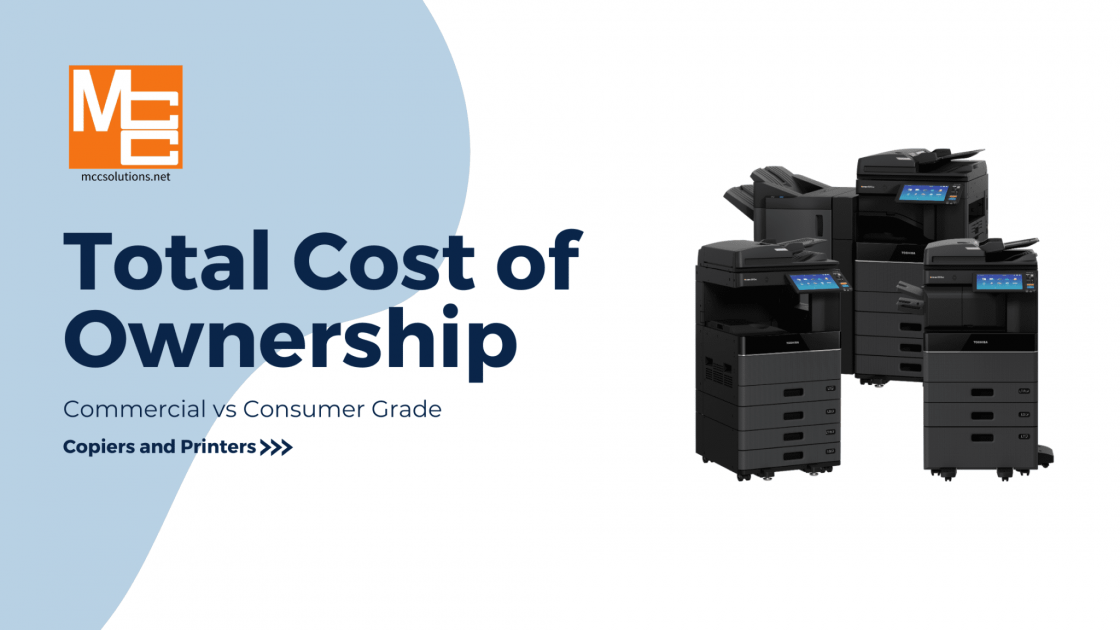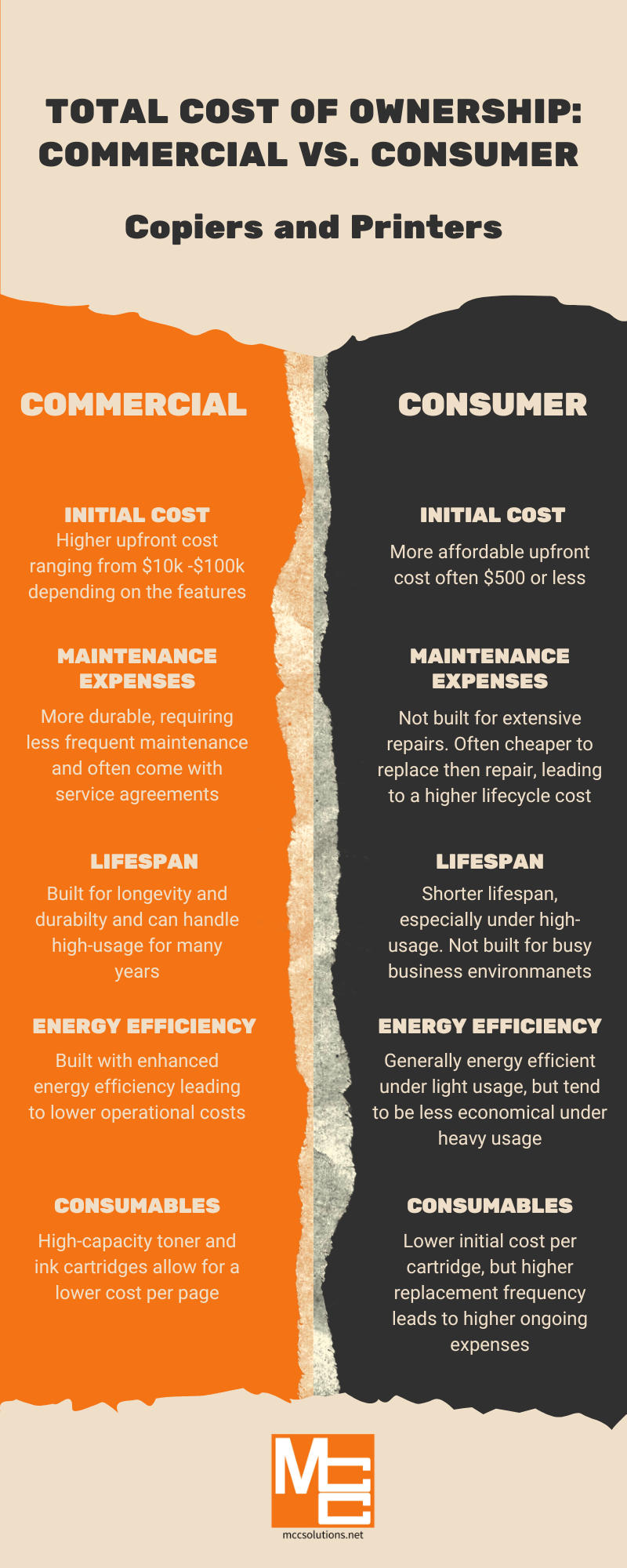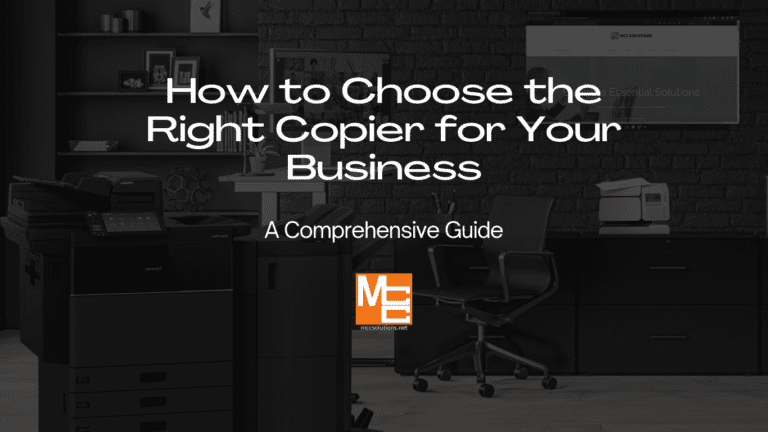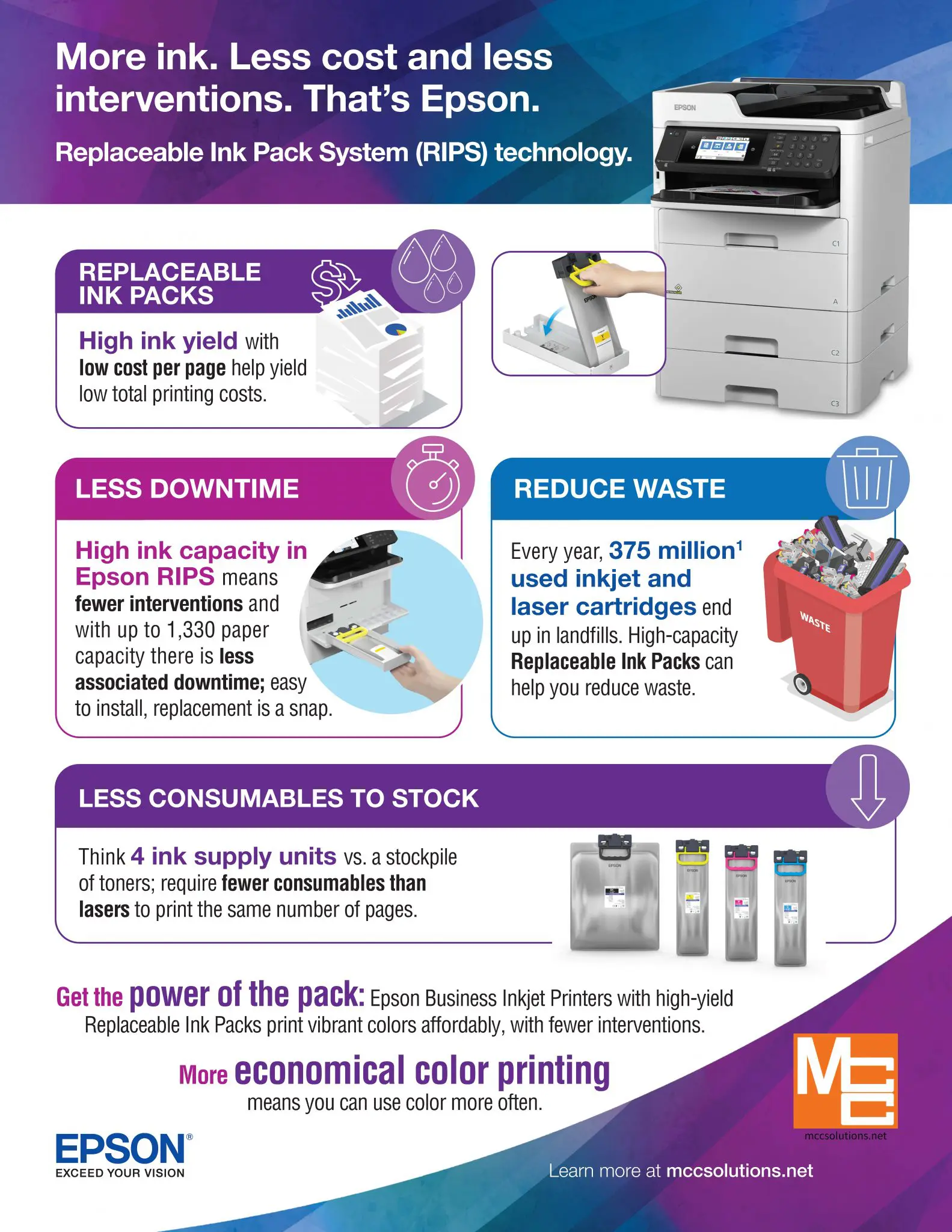Our Blog

Total Cost of Ownership: Commercial vs Consumer
Copiers and Printers
When it comes to choosing the right copier or printer for your business, understanding the Total Cost of Ownership (TCO) is absolutely crucial. TCO goes beyond just the initial purchase price; it encompasses all the expenses associated with owning and operating a device throughout its entire lifespan. This includes not only the acquisition cost but also ongoing expenses such as maintenance, repair costs, consumables like ink and toner, and the energy consumed during operation.
In this comprehensive guide, we will delve deeper into the differences between commercial and consumer-grade copiers and printers. We’ll focus on key factors that can significantly impact your decision-making process, including purchase costs, which can vary widely between models and brands, and maintenance requirements, which can affect downtime and productivity. We will also discuss the importance of consumables, as these recurring costs can add up over time, and how lifespan plays a role in determining long-term value. Additionally, we will examine energy efficiency, a critical factor for environmentally conscious businesses looking to reduce their carbon footprint. Lastly, we’ll consider usage capacity, which is essential for ensuring that the device meets the demands of your workload effectively. With this in-depth analysis, you’ll be better equipped to make an informed choice that aligns with your business needs and budget.
Total Cost Comparison
Initial Purchase Cost
Commercial Printers
Commercial-grade copiers and printers are specifically designed to handle high-volume and professional-grade outputs, making them ideal for businesses that require efficient and reliable printing solutions. These robust machines come equipped with advanced features such as high-speed printing, automatic duplexing, and large paper capacity, all tailored to meet the substantial printing demands of corporate environments. Additionally, many models offer enhanced connectivity options, allowing for seamless integration into office networks and mobile printing capabilities.
As a result of these sophisticated functionalities and the durability needed for continuous operation, the upfront cost of commercial devices can vary significantly, typically ranging from $10,000 to over $100,000, depending on the model, brand, and specific capabilities. While this initial investment may seem steep, it is often justified by the long-term benefits these devices provide, including improved durability, greater speed, and a wider range of functions that can streamline workflow and enhance productivity within the organization. Businesses often find that the reduced downtime and lower cost-per-page associated with commercial-grade machines lead to significant savings over time.
Consumer Printers
Consumer copiers and printers are generally more affordable, typically priced under $500, making them an attractive option for individuals and small offices. These printers are designed to meet the moderate printing needs of personal users or small businesses, offering a decent print quality for everyday documents, photos, and reports. While their lower initial cost is certainly appealing, it’s important for businesses to consider the long-term expenses associated with consumables, such as ink or toner cartridges, paper, and other supplies, which can add up over time. Additionally, potential maintenance costs should also be factored in, as regular upkeep may be necessary to ensure the printer remains in good working condition, especially with frequent use. Ultimately, it’s essential to weigh both the upfront investment and ongoing costs when selecting a printer for your needs.
Maintenance Expenses
Commercial Printers
Commercial printers are meticulously engineered for reliability and ease of service, making them ideal for high-demand environments. They typically come with comprehensive service agreements that cover not only parts and labor but also consumables such as toner and ink, which can significantly contribute to lower long-term maintenance costs. These agreements provide peace of mind, ensuring that any potential issues are addressed promptly without unexpected financial burdens. Regular maintenance is crucial, as it ensures that these machines remain operational and in top condition, minimizing downtime and maximizing productivity. Moreover, proactive upkeep can extend the lifespan of the equipment, enhancing the overall return on investment for businesses that rely heavily on printing services. By investing in a solid maintenance plan, companies can keep their printing operations running smoothly and efficiently.
Consumer Printers
Consumer-grade printers typically have lower upfront maintenance costs, making them an appealing option for casual users and small offices. However, these printers are generally not designed for extensive repairs, which means that when they do malfunction, the options for fixing them may be limited. In many cases, it is often more economical to replace the entire unit rather than invest in repairing a malfunctioning consumer printer. This situation can lead to higher lifecycle costs, particularly in environments with frequent printing needs, such as busy offices or schools where high-volume printing is a regular occurrence. Additionally, the reliance on lower-cost printers may result in more frequent replacements, further adding to the overall expenses over time.
Cost of Consumables
Consumer Printers
One of the most significant ongoing expenses for consumer-grade printers is the cost of ink and toner. These printers often use low-cost cartridges with limited page yields, necessitating frequent replacements. This strategy leads to higher ongoing costs, as manufacturers recoup their initial low prices through frequent consumable sales. Additionally, consumer printers require more frequent attention due to their limited cartridge capacities, which can be disruptive in a busy office environment.
Commercial Printers
In contrast, commercial-grade devices utilize high-capacity cartridges that offer a lower cost per page, despite higher initial costs. These cartridges require less frequent replacement, making them more economical for businesses with high print volumes. Designed to accommodate larger cartridges, commercial printers reduce the frequency of replacements, lowering the cost per page and minimizing operational disruptions associated with changing cartridges.
Lifespan
Commercial Printers
Built to withstand high usage over extended periods, commercial printers and copiers are engineered for durability, offering a significantly longer lifespan than consumer models. Their robust construction incorporates heavy-duty components and advanced technology, ensuring they can effectively handle the demanding needs of a busy business environment. These machines are designed for high-volume printing and copying, making them ideal for offices that require reliable performance and efficiency. By reducing the need for frequent replacements, businesses can save on costs and maintain productivity, allowing employees to focus on their core tasks without interruptions.
Consumer Printers
Consumer printers generally have a shorter lifespan compared to their commercial counterparts, particularly when subjected to heavy use. Unlike printers designed for business environments, which are built to withstand rigorous demands and high-volume printing, consumer models are not engineered for such intense workloads. This disparity in durability often leads to the need for more frequent replacements, which can significantly increase the total cost of ownership (TCO) over time. As a result, businesses may find that investing in high-quality, commercial-grade printers is more cost-effective in the long run, as they tend to offer greater reliability and performance.
Energy Efficiency
Commercial Printers
Commercial printers are often equipped with advanced energy-saving features that effectively minimize power consumption during idle times. These cutting-edge efficiencies not only contribute to significantly lower operational costs but also align with broader sustainability initiatives that many companies are striving to achieve. By utilizing technology that reduces energy consumption, businesses can benefit from lower energy bills without sacrificing their printing needs. Additionally, this commitment to sustainability can enhance a company’s reputation, attract environmentally conscious customers, and contribute to a healthier planet. Embracing energy-efficient printing solutions is a win-win for both the bottom line and the environment.
Consumer Printers
While consumer-grade printers are generally energy-efficient for light use, providing a cost-effective solution for occasional printing tasks, their efficiency can diminish with increased usage. As the volume of printing rises, these printers often exhibit higher energy consumption rates per page, which can lead to a significant increase in operational costs over time. This higher energy use not only impacts your electricity bill but may also necessitate more frequent maintenance and replacement of consumables, such as ink cartridges or toner. Therefore, for those who anticipate heavy usage, investing in a more robust model designed for higher volumes may ultimately prove to be a more economical choice in the long run.
Usage Capacity
Commercial Printers
With faster printing speeds, larger paper capacities, and the ability to handle various media types, commercial printers are immensely beneficial for organizations that deal with high print volumes. These advanced features not only support productivity and efficiency but also enable businesses to manage diverse printing needs—from high-quality color brochures to large-format posters and everything in between. By ensuring that large print jobs are completed promptly, these devices help organizations maintain smooth operations and meet tight deadlines, ultimately contributing to their overall success and client satisfaction.
Consumer Printers
Best suited for smaller print jobs, consumer printers typically have limited capacity and slower speeds compared to their commercial counterparts. These printers are designed to handle everyday tasks such as printing documents for home use or school assignments, which makes them convenient for individual users. However, in a business setting with substantial printing demands, these limitations can significantly bottleneck productivity and disrupt workflow. As companies often require high volumes of printing, relying solely on consumer printers can lead to delays, increased frustration, and potentially hinder overall efficiency in operations. Therefore, businesses may benefit from investing in more robust printing solutions that can handle larger tasks and faster speeds to meet their needs effectively.
Impact on Busines Sizes and Types
Large Enterprises
For large enterprises, commercial copiers and printers are often the preferred choice due to their exceptional ability to manage high volumes of printing and copying tasks efficiently and reliably. These machines are designed to handle the rigorous demands of busy office environments, where speed and productivity are critical. With robust features such as advanced finishing options, high-speed printing capabilities, and user-friendly interfaces, commercial copiers and printers streamline workflows and enhance overall efficiency. Additionally, their lower per-page costs make them a valuable asset for companies that require consistent output in high-demand settings, allowing businesses to save on operational costs while maintaining quality and performance. Investing in these advanced devices not only meets current needs but also positions enterprises for future growth and scalability.
Small to Medium Enterprises (SMEs)
The decision between commercial and consumer-grade devices for small and medium-sized enterprises (SMEs) hinges on a variety of factors, including specific operational needs and print volumes. High-quality consumer devices may be sufficient for businesses with smaller print volumes, offering an affordable solution without compromising too much on quality. However, as print demands increase or if the business involves high-stakes documents, a commercial device may be more suitable due to its durability and advanced features. Additionally, businesses must conduct a thorough analysis of the total cost of ownership (TCO), considering factors such as maintenance, consumables, and potential downtime, to make a fully informed decision that aligns with their long-term goals and budget constraints.
Startups and Small Offices
Startups and small offices often gravitate towards consumer models primarily because of their lower initial costs, which makes them an attractive option for businesses just starting out or operating on tight budgets. These models allow entrepreneurs to enter the market without making a significant financial commitment upfront. However, as the business expands and evolves, the needs of the organization may change. Transitioning to commercial models can become more economical in the long run, as these models often provide enhanced features, scalability, and support that are crucial for growth. By investing in commercial solutions, businesses can better accommodate increasing demands and improve overall efficiency, ultimately positioning themselves for greater success as they mature.
Selecting the appropriate copier or printer involves a thorough analysis of the Total Cost of Ownership. While consumer models may seem budget-friendly initially, commercial devices often deliver better value over time, especially for businesses with substantial printing needs. By evaluating current requirements and anticipating future growth, businesses can make informed decisions that align with their operational goals and budget constraints.
Boost your business efficiency by choosing the right copier or printer!
Contact us today for a free consultation and discover how our expert solutions can optimize your printing needs and reduce costs. Don't wait—unlock the potential for savings and productivity now!
Schedule a free consult today!Looking for something specific?
Want the latest news in your inbox?
Don't forget to share!
Categories
Industries
Solutions
MCC News







